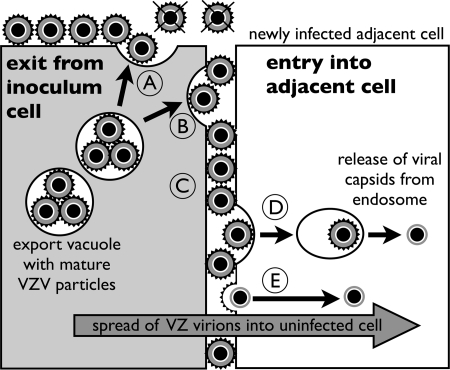FIG. 8.
Model of the cell-to-cell spread of VZV before cell fusion in vitro. Mature VZV particles are transported in an export vacuole to the plasma membrane of an infected inoculum cell (gray cell on left). (A) VZV particles released by exocytosis adhere to the plasma membrane at the interface with culture media. Infectious VZV particles are not released into the media or rapidly lose infectivity, since secondary plaques do not form in VZV-infected monolayers. (B) Some VZV particles are released from the inoculum cell in close proximity to the plasma membrane of the adjacent uninfected cell (white cell on right). (C) Envelope glycoproteins of extracellular VZV particles at these sites have an increased probability of binding to cell surface receptors on the plasma membrane of the uninfected cell. Entry into the adjacent cell occurs by endocytosis (D) or direct entry (E), which is followed by the release of partially tegumented capsids into the cytoplasm of the newly infected cell. Our model predicts that the spread of cell-associated extracelluar VZ virions in vitro is determined by the proximity of infected and uninfected cells and does not require cell fusion.

